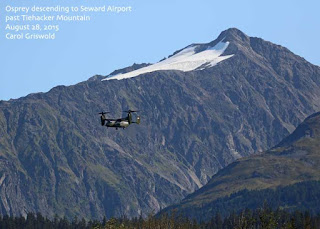Seward,
Alaska
The rumors
are true: President Obama is coming to visit Seward on September 1st!
The grapevine is buzzing with even more rumors, but the details have yet to be
revealed.
As if to confirm
the astonishing news, four impressive Osprey Tiltrotor Aircraft thundered
over the Seward Airport today. They had flown from Anchorage with their twin
prop-rotors in front like an airplane but on approach, the prop-rotors tilted
vertically like a helicopter to allow them to hover. The gnarly winds did not
faze them and they landed with ease and precision.
According to
various websites, the Osprey can cruise at 290 mph and travel more than 1000
miles. Once airborne, it can rotate the prop-rotors horizontally in as little
as 12 seconds. The prop-rotors are 38 feet in diameter.
Joined by
somber Blackhawks and gleaming green Whitehawk helicopters, the taxiway rumbled
and roared with restrained power. Men in Black watched as did many lucky
Sewardites. Cars swerved over to the side of the highway at the unexpected
sight and cameras clicked. Then, one by one, they taxied a short ways and
effortlessly lifted off, up, up and away into the blue sky. What a sight!
The unusual Ospreys
stole the show, but the two presidential helicopters also tested the approaches
and landings at the Seward Airport in the brutal, gusty wind.
The green and
white Sikorsky VH-60 helicopter becomes Marine One when the president is on
board. If only the vice president or other high-ranking members are on board,
it is known as Marine Two. When Marine One is in service, there are usually
several other decoy helicopters flying with it to protect the president. This
fleet is air-transported with the president anywhere in the world.
The VH-60N
White Hawk is 64.83' long, 53.67' wide, and 16.83' high. It can travel 183 mph
with a maximum range of 1379 miles, and climb 700' per minute. It looks very
impressive!
Happy Birding,
even if this flock of unusual birds lack feathers!
Carol Griswold
Seward, Alaska







































